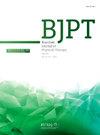在瑞典的初级卫生保健中,物理治疗师在管理腰痛患者时使用患者报告的结果测量与哪些因素相关?
IF 3.2
3区 医学
Q1 ORTHOPEDICS
引用次数: 0
摘要
据报道,物理治疗师在管理腰痛(LBP)患者时使用患者报告的结果测量(PROMs)的情况很低,特别是健康相关和社会心理因素。目的探讨影响初级保健物理治疗师使用特异性prom的相关因素。方法对1237名物理治疗师的数据进行分析。采用Logistic回归分析(奇数比(OR), 95%置信区间)来调查使用PROMs治疗疼痛、残疾、健康相关和心理社会因素与物理治疗师的人口统计学特征(包括教育水平)之间的关系。结果大多数物理治疗师使用PROMs治疗疼痛(83%),而使用PROMs治疗残疾(28%)、健康相关(14%)和社会心理因素(13%)的频率较低。女性(OR 2.57, 95% CI: 1.84, 3.59)和在私人诊所工作(OR 1.83, 95% CI: 1.27, 2.67)与使用PROMs治疗疼痛相关。拥有硕士或博士学位与使用PROMs治疗残疾(or 1.85, 95% CI: 1.28, 2.66)和心理社会因素(or 2.11, 95% CI: 1.19, 3.65)有关。女性(OR为1.51,95% CI为1.01,2.29)和高级临床专家(OR为2.09,95% CI为1.29,3.33)与使用PROMs进行健康相关因素相关。结论:虽然物理治疗师通常使用PROMs来治疗疼痛,但很少有人用它来评估健康相关和心理社会因素。那些具有较高教育水平或高级临床专家的人更有可能在管理LBP患者时纳入此类PROMs。未来的研究应探索教育干预,以提高对prom及其在生物心理社会框架内临床推理中的作用的理解。本文章由计算机程序翻译,如有差异,请以英文原文为准。
What factors are associated with physical therapists’ use of patient-reported outcome measures in managing patients with low back pain in primary health care in Sweden?
Background
Physical therapists' use of patient-reported outcome measures (PROMs) in managing patients with low back pain (LBP) is reportedly low, especially for health-related and psychosocial factors.
Objective
To investigate factors associated with using specific PROMs among physical therapists working in primary care.
Methods
We analyzed data collected from physical therapists (n = 1237). Logistic regression analyses (Odd Ratios (OR), 95 % Confidence Intervals) were conducted to investigate how using PROMs for pain, disability, health-related, and psychosocial factors is associated with the physical therapists' demographic characteristics, including educational levels.
Results
Most physical therapists used PROMs for pain (83 %), while PROMs for disability (28 %), health-related (14 %), and psychosocial factors (13 %) were used less frequently. Being female (OR 2.57, 95 % CI: 1.84, 3.59) and working in private clinics (OR 1.83, 95 % CI: 1.27, 2.67) were associated with using PROMs for pain. Holding a master’s degree or PhD was linked to using PROMs for disability (OR 1.85, 95 % CI: 1.28, 2.66) and psychosocial factors (OR 2.11, 95 % CI: 1.19, 3.65). Being female (OR 1.51, 95 % CI 1.01, 2.29) and being an advanced clinical specialist (OR 2.09, 95 % CI: 1.29, 3.33) were associated with using PROMs for health-related factors.
Conclusions
While physical therapists commonly use PROMs for pain, few use them to assess health-related and psychosocial factors. Those with higher educational levels or advanced clinical specialists are more likely to incorporate such PROMs in managing patients with LBP. Future studies should explore educational interventions to improve understanding of PROMs and their role in clinical reasoning within a biopsychosocial framework.
求助全文
通过发布文献求助,成功后即可免费获取论文全文。
去求助
来源期刊
CiteScore
6.10
自引率
8.80%
发文量
53
审稿时长
74 days
期刊介绍:
The Brazilian Journal of Physical Therapy (BJPT) is the official publication of the Brazilian Society of Physical Therapy Research and Graduate Studies (ABRAPG-Ft). It publishes original research articles on topics related to the areas of physical therapy and rehabilitation sciences, including clinical, basic or applied studies on the assessment, prevention, and treatment of movement disorders.

 求助内容:
求助内容: 应助结果提醒方式:
应助结果提醒方式:


